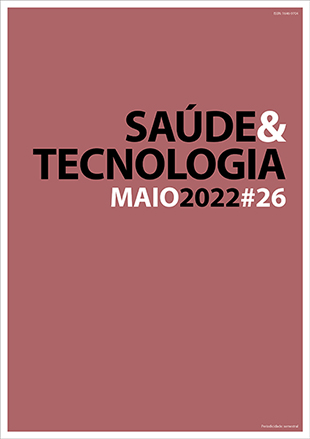Prefrontal cortex: the ultimate human evolution
DOI:
https://doi.org/10.25758/set.588Palavras-chave:
Prefrontal cortex, Brain development, Adolescence, Early adulthoodResumo
Prefrontal Cortex (PFC) is responsible for the acquisition, execution, and control of a wide range of functions, from basic motor responses to complex decision-making. Brain development and maturation begin during gestation and terminate, presumably, in late adolescence and early adulthood. Prefrontal Cortex is the latest developing region of the neocortex, explaining adolescents' emotional imbalance and immature, impulsive, excited, and risky behavior. Despite researchers’ efforts to clarify human brain maturation and hight-abilities, the early adulthood development stage is not fully understood. The aim of this review is to describe the role of frontal lobes, particularly of PFC, in differentiating human behavior and high functions and the impact of its development during late adolescence and early adulthood.
Downloads
Referências
Teffer K, Semendeferi K. Human prefrontal cortex: evolution, development, and pathology. Prog Brain Res. 2012;195:191-218.
Chayer C, Freedman M. Frontal lobe functions. Curr Neurol Neurosci Rep. 2001;1(6):547-52.
Rosch KS, Mostofsky S. Development of the frontal lobe. Handb Clin Neurol. 2019;163:351-67.
Ogilvie JM, Shum DH, Stewart A. Executive functions in late adolescence and early adulthood and their relationship with risk-taking behavior. Dev Neuropsychol. 2020;45(7-8):446-68.
Wahlstrom D, Collins P, White T, Luciana M. Developmental changes in dopamine neurotransmission in adolescence: behavioral implications and issues in assessment. Brain Cogn. 2010;72(1):146-59.
Tarokh L, Saletin JM, Carskadon MA. Sleep in adolescence: physiology, cognition and mental health. Neurosci Biobehav Rev. 2016;70:182-8.
Taupin P. Neurogenesis in the adult central nervous system. C R Biol. 2006;329(7):465-75.
Stiles J, Jernigan TL. The basics of brain development. Neuropsychol Rev. 2010;20(4):327-48.
Gelman SA, Taylor M. A review of: 'The fundamentals of brain development: integrating nature and nurture. By Joan Stiles.' J Cogn Dev. 2010;11(3):393-6.
Stiles J. The fundamentals of brain development: integrating nature and nurture. Cambridge: Harvard University Press; 2008.
Thomason ME. Development of brain networks in utero: relevance for common neural disorders. Biol Psychiatry. 2020;88(1):40-50.
Cohen-Sacher B, Lerman-Sagie T, Lev D, Malinger G. Sonographic developmental milestones of the fetal cerebral cortex: a longitudinal study. Ultrasound Obstet Gynecol. 2006;27(5):494-502.
Javed K, Reddy V, Lui F. Neuroanatomy, cerebral cortex [Internet]. Treasure Island: StatsPearls Publishing; 2022. Available from: https://www.ncbi.nlm.nih.gov/books/NBK430685/
Johnson MH. Functional brain development in humans. Nat Rev Neurosci. 2001;2(7):475-83.
Arain M, Haque M, Johal L, Mathur P, Nel W, Rais A, et al. Maturation of the adolescent brain. Neuropsychiatr Dis Treat. 2013;9:449-61.
Crone EA, Ridderinkhof KR. The developing brain: from theory to neuroimaging and back. Dev Cogn Neurosci. 2011;1(2):101-9.
Walhovd KB, Westlye LT, Amlien I, Espeseth T, Reinvang I, Raz N, et al. Consistent neuroanatomical age-related volume differences across multiple samples. Neurobiol Aging. 2011;32(5):916-32.
Jernigan TL, Gamst AC. Changes in volume with age: consistency and interpretation of observed effects. Neurobiol Aging. 2005;26(9):1271-8.
Catani M. Chapter 6: the anatomy of the human frontal lobe. Handb Clin Neurol. 2019;163:95-122.
Risberg J, Grafman J. The frontal lobes: development, function, and pathology. New York: Cambridge University Press; 2006. ISBN 9780521672252
Beaver JD, Lawrence AD, van Ditzhuijzen J, Davis MH, Woods A, Calder AJ. Individual differences in reward drive predict neural responses to images of food. J Neurosci. 2006;26(19):5160-6.
Barrós-Loscertales A, Meseguer V, Sanjuán A, Belloch V, Parcet MA, Torrubia R, et al. Striatum gray matter reduction in males with an overactive behavioral activation system. Eur J Neurosci. 2006;24(7):2071-4.
Ernst M. The triadic model perspective for the study of adolescent motivated behavior. Brain Cogn. 2014;89:104-11.
Hahn T, Dresler T, Ehlis AC, Plichta MM, Heinzel S, Polak T, et al. Neural response to reward anticipation is modulated by Gray’s impulsivity. Neuroimage. 2009;46(4):1148-53.
Hahn T, Dresler T, Plichta MM, Ehlis AC, Ernst LH, Markulin F, et al. Functional amygdala-hippocampus connectivity during anticipation of aversive events is associated with Gray’s Trait 'sensitivity to punishment'. Biol Psychiatry. 2010;68(5):459-64.
Fuster JM. Frontal lobe and cognitive development. J Neurocytol. 2002;31(3-5):373-85.
Grafman J. Human prefrontal cortex: processes and representations. In: Risberg J, Grafman J, editors. Frontal lobes: development, function and pathology. New York: Cambridge University Press; 2006. p. 69-91.
Draper IT. The working brain: an introduction to neuropsychology. J Neurol Neurosurg Psychiatry. 1974;37(3):361-2.
Downloads
Publicado
Edição
Secção
Licença
Direitos de Autor (c) 2022 Saúde & Tecnologia

Este trabalho encontra-se publicado com a Licença Internacional Creative Commons Atribuição-NãoComercial-SemDerivações 4.0.
A revista Saúde & Tecnologia oferece acesso livre imediato ao seu conteúdo, seguindo o princípio de que disponibilizar gratuitamente o conhecimento científico ao público proporciona maior democratização mundial do conhecimento.
A revista Saúde & Tecnologia não cobra, aos autores, taxas referentes à submissão nem ao processamento de artigos (APC).
Todos os conteúdos estão licenciados de acordo com uma licença Creative Commons CC-BY-NC-ND. Os autores têm direito a: reproduzir o seu trabalho em suporte físico ou digital para uso pessoal, profissional ou para ensino, mas não para uso comercial (incluindo venda do direito a aceder ao artigo); depositar no seu sítio da internet, da sua instituição ou num repositório uma cópia exata em formato eletrónico do artigo publicado pela Saúde & Tecnologia, desde que seja feita referência à sua publicação na Saúde & Tecnologia e o seu conteúdo (incluindo símbolos que identifiquem a revista) não seja alterado; publicar em livro de que sejam autores ou editores o conteúdo total ou parcial do manuscrito, desde que seja feita referência à sua publicação na Saúde & Tecnologia.







